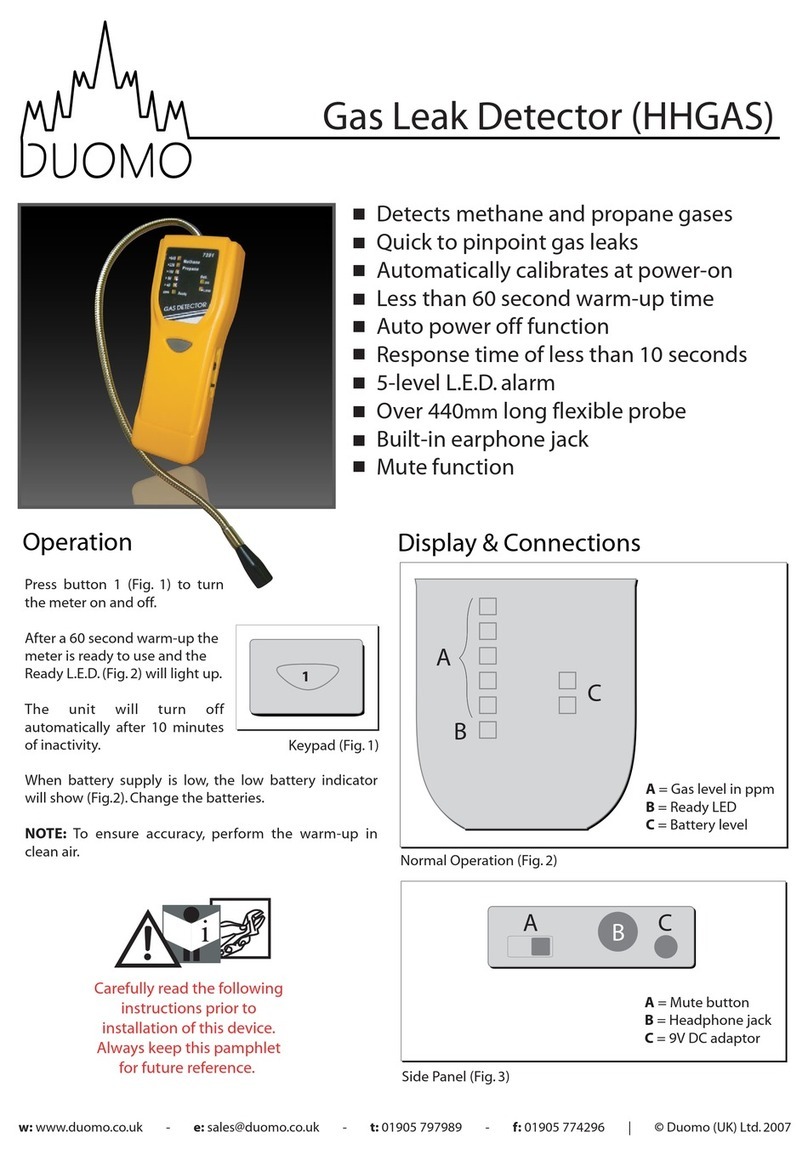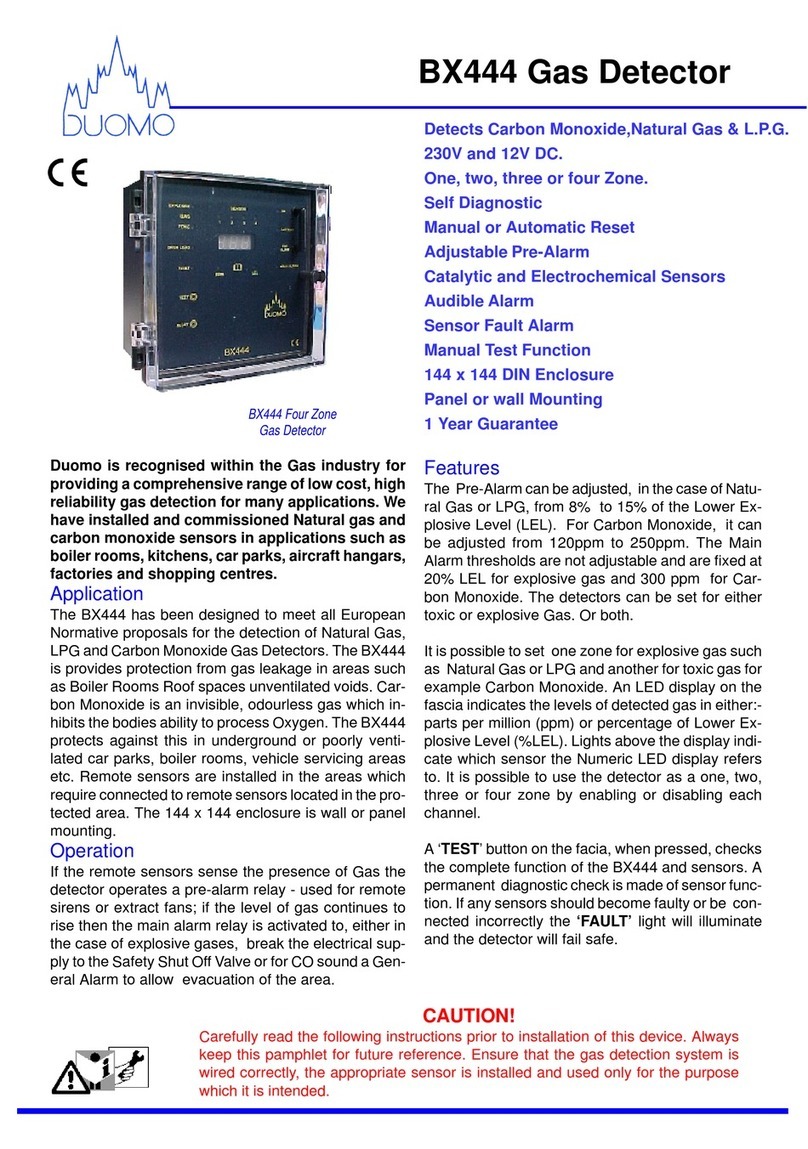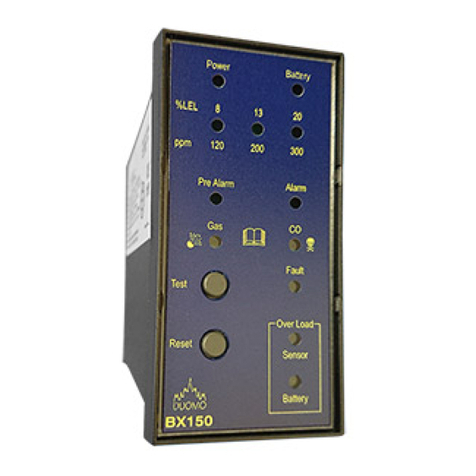
8. Ventilation Fan Important Note:
Any ventilation fan connected to this device must
bring air into the room and not exhaust from it.
Exhaust gases from fuel burning appliances installed
in the home may be drawn back from the ue sys-
tem, if the action of an extractor fan (airow from
inside to outside) is stronger than the ue draught.
In the event of a partially or fully blocked ue, the
extraction fan may increase the release of exhaust
gases into the room, and also the subsequent in-
creased production of carbon monoxide.
A ventilation fan can increase the ventilation rate,
provided that the airow it creates is from outside
to inside. It is essential to establish that any fan used
to increase ventilation is correctly installed to ensure
that the air supply inside the premises is not im-
paired by airow from inside to outside.
9. Avoiding False alarms
This detector is designed to minimise the possi-
bility of nuisance alarms. It is however possible
that the detector could also respond to brief
exhaust gas emissions, for example during the
initial start-up of an appliance. Also, hydrogen acts
as an interferent and can arise from some battery
charging activities and the curing of concrete
or cement under certain circumstances. Volatile
Organic Compounds (VOCs), e.g. alcohols, which
may eventually activate the alarm, can be generat-
ed from use of damp-proong materials or other
coatings containing alkylalkoxysilanes.
If any of the above contaminant gases are likely
to be temporarily produced in the vicinity of the
CHCO detector increase ventilation by open doors
or windows.
Toxic eects of Carbon
Monoxide
Carbon monoxide (CO) is a colourless, odourless,
non-irritating gas classied as a chemical asphyxiant
whose toxic action is a direct result of the hypox-
ia produced by a given exposure - CO is rapidly ab-
sorbed through the lungs, diuses across the alveolar
capillary membrane and is reversibly
bound with haemoglobin as carboxyhaemoglobin
(COHb).
The anity of haemoglobin for CO is over 200 times
its anity for oxygen. This reduces the oxygen carry-
ing capacity of the blood, and has an eect on the
dissociation of oxyhaemoglobin, which further re-
duces the oxygen supply to the tissues. CO is chemi-
cally unchanged in the body, and is eliminated in ex-
pired air. The elimination is determined by the same
factors that applied during absorption. The half-life
while breathing room air is 2 h - 6,5 h depending on
the initial COHb level.
If the CO level in the inhaled air is constant, the level
of COHb in the blood will approach an equilibrium
(Saturation) state after several hours. However, the
rate at which the equilibrium is reached depends on
many factors, e.g. lung ventilation rate (physical activ-
ity) and alveolar capillary transfer, cardiac parameters,
initial blood haemoglobin concentration, barometric
pressure, oxygen and carbon dioxide concentration
in the inhaled air, but the two most important factors
in determining the COHb level are the CO concentra-
tion and the duration of exposure.
Table 2. Health eects of COHb blood levels on
healthy adults
% COHb Eects
0,3 – 0,7 Normal range in non-smokers due to
endogenous CO production
0,7 – 2,9 No proven physiological changes
2,9 – 4,5 Cardiovascular changes in cardiac
patients
4 – 6 Usual values observed in smokers,
impairment in psycho-motor tests
7 – 10 Cardiovascular changes in non-cardiac
patients (increased cardiac output
and coronary blood ow)
10 – 20 Slight headache, weakness, potential
burden on foetus
20 – 30 Severe headache, nausea, impairment
in limb movements
30 – 40 Severe headache, irritability, confu-
sion, impairment in visual acuity, nau-
sea, muscular weakness, dizziness
40 – 50 Convulsions and unconsciousness
60 – 70 Coma, collapse, death
Source: U.S. Environmental Protection Agency
1984
10.





































